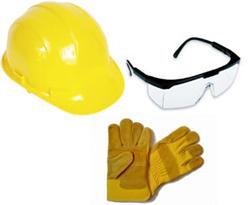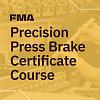Safety Coordinator
- FMA
- The Fabricator
- FABTECH
- Canadian Metalworking
Categories
- Additive Manufacturing
- Aluminum Welding
- Arc Welding
- Assembly and Joining
- Automation and Robotics
- Bending and Forming
- Consumables
- Cutting and Weld Prep
- Electric Vehicles
- En Español
- Finishing
- Hydroforming
- Laser Cutting
- Laser Welding
- Machining
- Manufacturing Software
- Materials Handling
- Metals/Materials
- Oxyfuel Cutting
- Plasma Cutting
- Power Tools
- Punching and Other Holemaking
- Roll Forming
- Safety
- Sawing
- Shearing
- Shop Management
- Testing and Measuring
- Tube and Pipe Fabrication
- Tube and Pipe Production
- Waterjet Cutting
Industry Directory
Webcasts
Podcasts
FAB 40
Advertise
Subscribe
Account Login
Search
It's the small things
Addressing areas that might be overlooked in safety programs
- By Kelly Langdon
- June 26, 2007
- Article
- Safety
Have you ever noticed in life that it's the collection of small things that determine our quality of life? This concept also can be applied to an industrial safety program.
Aeroglide's Safety Committee compiles a list of safety topics at the end of each year. These topics then are covered the following year, with specific items targeted each month. We so often write and instruct on large, glaring issues but neglect lesser, though very important, areas. This article provides examples of common topics that have a direct impact on safety, the bottom line, and employee attitudes and perceptions.
Hot Weather
Each year our company addresses heat safety at the beginning of hot-weather season. Our manufacturing area is not air-conditioned. Working in a non-air- conditioned plant in North Carolina during a hot and humid August is not comfortable. However, we have learned from experience that many small things can be done about the situation to improve employee attitudes and thus affect production.
We provide packets of electrolyte fluids that can be added to a glass of cold water to replenish fluids lost from perspiration. This is a small gesture with high impact. Working in a hot environment with no relief becomes psychologically stressing, and being able to replenish basic fluids and rehydrate yourself without having to purchase a new soda or water every 15 to 30 minutes becomes a big deal.
Based on the job requirements in our industry, all employees must wear personal protection equipment (PPE) while in the manufacturing area. Basic PPE includes (but is not limited to) steel-toe shoes, safety glasses, and hard hats. Hard hats and safety glasses are wonderful and positive until you wear them in 90-degree temperatures with humidity that seems to form a cloud over your head as you work. In these conditions, these small, beneficial items become big hindrances to comfort.
We have searched diligently for glasses that are safe but also lighter and fog-free. Bulky, heavy glasses add stress. With today's technology, it's easier to find materials that weigh less and yet carry higher required safety values than those of yesteryear.
Hard hats are another small item that add warmth in the winter but can become little head ovens in the summer. We pushed our vendors to develop ANSI-rated hard hats with some type of venting in the top so that the heat could escape and air could somehow flow throughout the shell. The hats also needed to weigh less yet still meet protection requirements. The industry has responded, and lighter-weight hats with venting are available.
Even steel-toe shoes have become lighter over time. Be sure to offer your employees the opportunity to try these new products. The cost usually is very close to that of traditional shoes, and the positive impact is tremendous.
Look for heat-generating equipment within your manufacturing facility and seek methods of transferring the heat out of the building or moving the heat source away from employees.
The New American Work Force
Regardless of your personal feelings about immigration and the face of our new American work force, companies must deal objectively and honestly with all people. This seems to be such a simple concept, and one that is handled as it should be, but some companies have neglected the small things in this area as well.
Simple safety literature usually is distributed throughout a manufacturing facility in one primary language, and we assume folks should be able to read it. This may work in some areas of the business, but we must not allow ourselves to assume safety is one of these areas. We have an obligation to send our workers home as healthy as they arrived.
The Occupational Safety and Health Administration (OSHA) now provides many publications in multiple languages. Many OSHA Quick Cards can be printed in your language of choice. When you print heat-stress safety cards for the summer or lockout/tagout cards, consider the group for which the information is intended. If the primary group in a particular department is Hispanic, the cards should be printed in Spanish as well as English.
As a rule of thumb, I now print all important safety documentation in the primary languages spoken in Aeroglide's facility. I also use this approach when designing safety training presentations for forklift, overhead crane training, and other safety instruction.
It also is important to consider the languages and cultural differences among employees within a facility when choosing emergency response team (ERT) members and the methods in which they will operate. This is another small thing that could potentially manifest itself in a big way when dealing with injuries if you cannot communicate verbally with the injured employee, or if you are culturally misunderstood while attempting to administer general first aid or other life-saving treatment.
Hand Safety
Some very simple concepts regarding hand safety could save many companies much grief. Have you ever heard the phrase "death by a thousand cuts"? Our company manufactures capital equipment in which we use vast amounts of steel, including tubing, angle, and sheets with varying thicknesses. Many would assume that a standard leather glove would keep us safe.
Gloves that work effectively for handling raw angle are very different from those best-suited for loading lubricated sheet steel into a punch press. Companies that fail to provide proper gloves is another minor detail that can generate big dollar losses over a period of time—death by a thousand cuts.
Aeroglide recently started providing sheet steel handlers with Kevlar®-lined leather gloves. Although slightly better than no gloves, standard leather-palm gloves can be sliced by thin sheet steel, which can result in cuts.
Not every employee will need the Kevlar-lined glove. It is important to educate employees why different tasks require different gloves. Some workers may feel their jobs are less important because their co-worker has a special glove. This scenario may seem elementary, but again, simple communication on such a small issue can spare hard feelings and employee stress during critical production runs.
Small things can make or break a person's morale. The principle can be compared to having a stone in your sock. The stone can cause you to favor that foot, only to find the same night that you now have a sore back from putting more weight on the other foot during that day. The following morning you may wake up with a sore neck and a headache because your back is misaligned. And so it goes.
This same analogy can and does apply to safety. Safety is not an area of business that should be bandaged and patched half-heartedly. (No pun intended.) Safety professionals must seek out those small irritants, which first and foremost have an adverse impact on safety. Second, these irritants impede production. In both cases, these small irritants negatively affect the bottom line and overall employee health.
This article merely scratches the surface of possible small safety-related issues. I encourage all companies to fit this article to your specific needs. Apply thelogicas you seek out those small areas that may be festering into a larger infection. Remember, safety professionals should be in the business of sending workers home in the same or better physical condition than when they arrived on the job.
About the Author

Kelly Langdon
100 Aeroglide Drive
Cary, NC
919-851-2000
subscribe now

The Fabricator is North America's leading magazine for the metal forming and fabricating industry. The magazine delivers the news, technical articles, and case histories that enable fabricators to do their jobs more efficiently. The Fabricator has served the industry since 1970.
start your free subscription- Stay connected from anywhere

Easily access valuable industry resources now with full access to the digital edition of The Fabricator.

Easily access valuable industry resources now with full access to the digital edition of The Welder.

Easily access valuable industry resources now with full access to the digital edition of The Tube and Pipe Journal.
- Podcasting
- Podcast:
- The Fabricator Podcast
- Published:
- 05/07/2024
- Running Time:
- 67:38
Patrick Brunken, VP of Addison Machine Engineering, joins The Fabricator Podcast to talk about the tube and pipe...
- Industry Events
World-Class Roll Forming Workshop
- June 5 - 6, 2024
- Louisville, KY
Advanced Laser Application Workshop
- June 25 - 27, 2024
- Novi, MI
Precision Press Brake Certificate Course
- July 31 - August 1, 2024
- Elgin,
































